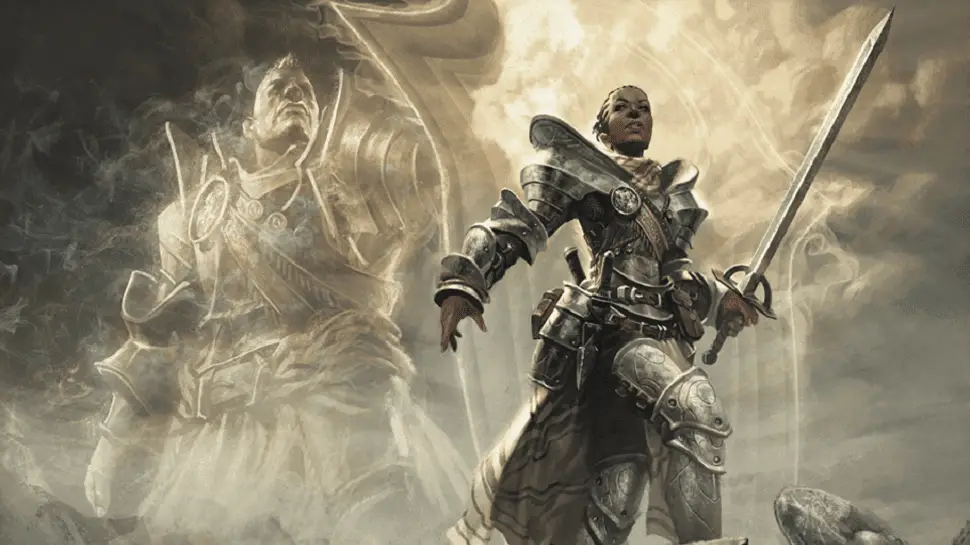The Oath of Redemption Paladin in D&D 5e is one of the more interesting subclasses in the game.
In a game largely defined by slaying monsters, kicking in doors, and looting as much treasure as you can haul, it’s a bit of a weird choice to play a pacifist.
But you know what they say: “an eye for an eye leaves the whole world blind.”
So maybe you’ve instead found yourself called to the righteous path of peace, love, and understanding. In a world where great evils are on the rise, you might seek to be a voice of reason and compassion.
We could all use a little more of that. But how do you do it while keeping your head on your shoulders?
Find out in this full subclass guide to the Oath of Redemption Paladin in D&D 5e!
What is the Oath of Redemption Paladin in D&D 5e?
The Oath of Redemption Paladin was originally published in Xanathar’s Guide to Everything. It appears alongside the Oath of Conquest Paladin which is basically the polar opposite of this subclass.
These Paladins have sworn themselves to upholding peace. They hold the concepts of understanding, justice, and benevolence in the highest regard.
Fitting with the name, the Oath of Redemption Paladin firmly believes that there is at least a small amount of light in every person. No matter how wicked that person may be, there is at least some part of them that could be convinced to be good.
This process is a slow one, but it comes through conversation, understanding, and building trust.
Now, that’s not to say that they’re naïve. They fully understand that creatures like the undead, devils, demons or other such creatures cannot be reasoned with.
But for those capable of reason, the Oath of Redemption Paladin seeks to make a breakthrough. If someone is shown the error of their ways and given the opportunity to grow, they can be redeemed.
It is only when all attempts at words and reason have failed that an Oath of Redemption Paladin will raise their weapon. In those moments, these Paladins commit fully and without hesitation to the greater good.
Tenets of the Oath of Redemption
The tenets of the Oath of Redemption Paladin put on emphasis on nonviolence, mercy, and understanding.
They acknowledge that violence is sometimes the only option but promote might as a way to deter violence rather than provoke it.
Peace: Violence is a weapon of last resort. Diplomacy and understanding are the paths to long-lasting peace.
Innocence: All people begin life in an innocent state. It is their environment or the influence of dark forces that drives them to evil. By setting the proper example and working to heal the wounds of a deeply flawed world, you can set anyone on a righteous path.
Patience: Change takes time. Those who have walked the path of the wicked must be given reminders to keep them honest and true. Once you have planted the seed of righteousness in a creature, you must work day after day to allow that seed to survive and flourish.
Wisdom: Your heart and mind must stay clear for eventually you will be forced to admit defeat. While every creature can be redeemed, some are so far along the path of evil that you have no choice but to end their lives for the greater good.
Any such action must be carefully weighed, and the consequences fully understood, but once you have made the decision, follow through with it knowing your path is just.
Role in the Party
Healing and support are the main focuses of the Oath of Redemption Paladin in D&D 5e. Most of your spells and subclass features are strongly geared towards these roles.
Oath of Redemption Paladins especially benefit from taking the Blessed Warrior fighting style from Tasha’s Cauldron of Everything. I would even go so far as to say it’s mandatory.
Having a high Charisma is essential to playing an Oath of Redemption Paladin. Fortunately, that makes you an even better Face for the party that can possibly deescalate conflict before it turns into violence.
Strength or Constitution can be your second priority, but Charisma absolutely needs to be your first.
Your Charisma directly affects your spell save DC. If you don’t make it a priority to max out your Charisma score, you’ll find yourself wasting many of your precious few spell slots.
However, you’re still a Paladin which means you’re tougher than most. You’re still perfectly capable of standing at the front of the party and holding your own.

Oath of Redemption Paladin Features 5e
We’ve covered your role in the party, now let’s look at the abilities you gain from the Oath of Redemption.
Once again, your spells and subclass features are incredibly important. However, they are much less impressive if enemies can easily make their saves against them.
A higher Charisma score is the key to getting the most value out of these!
Oath of Redemption Spells
Your Sacred Oath grants you bonus spells meant to help you build on your subclass’s theme.
At each of the levels that you see on the table, you gain bonus spells. These spells are always prepared and don’t count against the number of spells you can prepare each day.
If a spell isn’t from the Paladin spell list, it still counts as a Paladin spell for you.
| Paladin Level | Oath Spells |
| 3 | Sanctuary, Sleep |
| 5 | Calm Emotions, Hold Person |
| 9 | Counterspell, Hypnotic Pattern |
| 13 | Otiluke’s Resilient Sphere, Stoneskin |
| 17 | Hold Monster, Wall of Force |
Thoughts on the Oath of Redemption Paladin’s Spell List
Sanctuary is a great defensive spell for anyone, but especially for you. It can give you a safe way to try to talk some sense into someone who is being… well… less than cooperative…
Sleep is a good spell at the lower levels and a good nonviolent spell option. It does get much less useful as you continue to level up, though. With Paladins being half-casters, you won’t get much use out of this one in most cases.
Calm Emotions is a great and fairly reliable way of getting a group of people to just chill out for a minute. For those who won’t calm down, Hold Person is a great way to make your point. If they’re humanoid, that is.
Counterspell is always fantastic to have up your sleeve. You’ll likely still need to roll to see if you counter most spells, but this could still singlehandedly prevent a TPK. Hypnotic Pattern is a fun spell that will leave a group completely dazed and confused.
Whether you need it for offensive or defensive purposes, Otiluke’s Resilient Sphere is just a great spell. If an enemy needs to go into a timeout, just trap them in a magical bubble.
If you expect to get smacked around a bit, Stoneskin will help you cut that damage in half. Just be aware that you’ll need 100gp of diamond dust for each casting of it, so use it sparingly!
Hold Monster is great for all the reasons that Hold Person is great. But Wall of Force is really your standout spell at this level. The options are nearly limitless for how you can use it, though trapping enemies in an invisible box is always particularly fun.
Related: The Best Paladin Spells by Level in D&D 5e
Channel Divinity (Level 3)
Like all Paladins, the Oath of Redemption Paladin gives you two options for how to use your Channel Divinity.
You can use Channel Divinity once per short or long rest as a Paladin.
Emissary of Peace: You can use your Channel Divinity to augment your presence with divine power. As a bonus action, you grant yourself a +5 bonus to Charisma (Persuasion) checks for the next 10 minutes.
You’ll be focusing on Charisma for your various Oath of Redemption features and spells, so it’s only fitting that you get a bonus to help you as the party’s Face. After all, you’ve got a message to share, and spending your Channel Divinity to be extra persuasive in a dire RP moment is well worth it!
Rebuke the Violent: Immediately after an attacker within 30 feet of you deals damage with an attack against a creature other than you, you can use your reaction to force the attacker to make a Wisdom saving throw.
On a failed save, the attacker takes radiant damage equal to the damage it just dealt. On a successful save, it takes half as much damage.
This option for your Channel Divinity is more combat-oriented.
You don’t prevent the damage your ally has just taken, but you do swiftly punish the one who inflicted it on them.
Keep in mind that you’ve only got one of these per short or long rest. If you’re going against creatures that don’t hit hard but prefer to swarm, this won’t likely be as useful.
Against an enemy like an Ogre or Giant that deals a single big hit (or just landed a critical hit), this can send a strong message.
Aura of the Guardian (Level 7)
At level 7, you gain the Aura of the Guardian feature. This gives you an interesting way to use your reaction and prevent damage that your allies take.
When a creature within 10 feet of you takes damage, you can use your reaction to magically take that damage, instead of that creature taking it.
This feature doesn’t transfer any other effects that might accompany the damage, and this damage can’t be reduced in any way.
At level 18, the range of this aura increases to 30 feet.
Since this uses your reaction, you can only use it once per round.
Note that taking an attack of opportunity or imposing disadvantage on an attack with the Protection fighting style also requires a reaction. Use your reactions wisely!
It’s a little weird, but this is basically the Oath of the Crown Paladin‘s Divine Allegiance feature with better range.
Realistically, you should have plenty of healing and defensive options to make this work well for you. It’s especially useful for taking some heat off squishier party members.
If you use this constantly, you’ll have a rough time. In those moments when you really need it (like if an ally is about to drop to zero hit points), this is excellent.
A good Constitution score will help you have plenty of hit points. You might even consider taking the Tough feat if you plan on using this regularly!
Related: Feats in D&D 5e Explained

Protective Spirit (Level 15)
“Passive” is the name of the game for the Oath of Redemption Paladin. So how fitting that you’ve got some passive self-healing now, too!
You regain hit points equal to 1d6 + half your Paladin level if you end your turn in combat with fewer than half of your hit points remaining, and you aren’t incapacitated.
When you gain this, you’ll be healing between 8 and 13 points per round if you’re under half of your total hp. This works great alongside your Aura of the Guardian feature and will let you shoulder the damage burden for your allies even more!
On the list of things that are awesome in a subclass, free healing is towards the top of the list!
Emissary of Redemption (Level 20)
The capstone feature for the Oath of Redemption Paladin sees you becoming the very avatar of peace itself.
Where most Paladins’ capstone feature lets them gain several benefits for 1 minute, yours is always on. Well, in most circumstances anyways, though we’ll talk about that in a minute.
You gain two passive benefits with the Emissary of Redemption feature:
You have resistance to all damage dealt by other creatures (their attacks, spells, and other effects).
Whenever a creature hits you with an attack, it takes radiant damage equal to half the damage you take from the attack.
We’re starting strong with resistance to damage from other creatures! Swords, arrows, spells, whatever… You’re only taking half damage!
Of that half damage you take, they’re eating half of it themselves as radiant damage.
So, if an enemy hits you for 40 points of damage, you’re only taking 20. Since you took 20 damage, that enemy is now taking 10 radiant damage themselves.
You don’t need to activate this or anything. It’s just there provided you’ve been a good Oath of Redemption Paladin!
If you attack a creature, cast a spell on it, or deal damage to it by any means but this feature, neither benefit works against that creature until you finish a long rest.
If combat is inevitable, keep track of which enemies you have attacked, cast a spell on, or dealt damage to. Those you haven’t raised your weapon against will find you to be a very frustrating enemy!

Connections
As an Oath of Redemption Paladin, you’re a strange one. In many ways, you’re pretty firmly the opposite of what most people think about when they think of Paladins!
Something at some point caused you to choose a life of peace. What was it?
While it might be difficult to maintain the tenets of your Oath, you believe in them so firmly that you are willing to give every opportunity to those you encounter. What have you sacrificed in the name of this greater good?
There are many ways to tie an Oath of Redemption Paladin into the game world and story. It’s tying them in with the group that I admittedly struggle with…
In the vast majority of games, I have a hard time seeing the Oath of Redemption Paladin fitting in with the party. You may have chosen a life of peace and pacifism, but your party cannot wait to storm the dungeon and carve their way through everyone and everything they encounter to get that precious loot.
Presumably, you’ll be healing and protecting these allies of yours. (Otherwise, that’s an entirely different conversation.)
If you’re helping them commit acts of violence, you are simply not a pacifist. Just because you’re not swinging the sword or throwing the fireball doesn’t mean you’re not just as much a part of that as the others!
So, where’s the line here?
If you have ideas for how an Oath of Redemption Paladin would fit in with a standard D&D party and adventure, please let me know in the comments.
It’s honestly my sole complaint about this class!
Is the Oath of Redemption Paladin Good?
So… this is a bit of a difficult question to answer directly. There are two lenses that have to be looked through: mechanics and theme.
Mechanically, the Oath of Redemption Paladin is incredibly good. It brings the toughness of the Paladin class and plays to Paladins’ abilities as healers and shields for their allies.
With an incredible spell list and a great assortment of features, the Oath of Redemption Paladin is a very solid choice as a defensive Paladin.
When we’re talking about the subclass’s mechanics, it’s a very high-tier pick!
But as I mentioned in the last section, where I have a hard time with the Oath of Redemption Paladin is the theme.
The very nature of D&D is fighting evil creatures and taking their treasure. At least in my years of experience, that’s a core part of most D&D games.
Considering that the Redemption Paladin’s power comes from a dedication to creating peace and understanding, they must maintain the tenets of their Oath. The problem is that this might drive the rest of the party absolutely bonkers.
“No. We are not going to listen to the evil necromancer’s side of the story to find common ground.”
“No. We absolutely will not ask the cult nicely to stop kidnapping villagers to use as sacrifices to their demonic overlord.”
Depending on what definition of peace we’re using, are you any less to blame for healing and protecting your party while they annihilate an entire cave of goblins?
While the Oath of Redemption Paladin is mechanically very good, the theme is what I have trouble with. It just seems at odds with what the majority of D&D games are.
Your character may be here to share the message and beauty of peace, love, and understanding. That’s nice.
But the rest of us are here to play D&D…
See how the Oath of Redemption stacks up in the Paladin Subclasses Ranking!
Conclusion – Oath of Redemption Paladin in D&D
Ok, you’ll have to forgive the rant there. I truly want to love this class but sticking to the theme really pigeonholes it into a very specific type of party within a very specific type of game.
If you’re only fighting undead or fiends, those are pretty safely excluded from the Redemption Paladin’s tenets. Likewise, if you’re playing a game that’s very light on combat, this could fit well.
But I’m trying to think of just a general D&D game where they would fit comfortably and I’m drawing a blank…
I’m genuinely curious if I’m in the minority here and would love to read your thoughts in the comments!
Don’t forget to sign up for the Tabletop Joab newsletter! It’s the best way to get all the latest player guides, DM Tips, news, reviews, and more for D&D 5e right to your inbox!
You can also follow me on Facebook and Twitter.
If you found this article helpful and want to support the site, you can buy me a coffee here! (It’s not expected, but very appreciated!)









